
Lichenology is the branch of mycology that studies the lichens, symbiotic organisms made up of an intimate symbiotic association of a microscopic alga with a filamentous fungus.

Lichen planus (LP) is a chronic inflammatory and immune mediated disease that affects the skin, nails, hair, and mucous membranes. It is characterized by polygonal, flat-topped, violaceous papules and plaques with overlying, reticulated, fine white scale, commonly affecting dorsal hands, flexural wrists and forearms, trunk, anterior lower legs and oral mucosa. Although there is a broad clinical range of LP manifestations, the skin and oral cavity remain as the major sites of involvement. The cause is unknown, but it is thought to be the result of an autoimmune process with an unknown initial trigger. There is no cure, but many different medications and procedures have been used in efforts to control the symptoms.
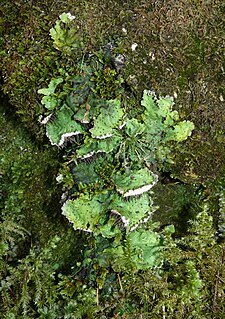
Peltigera is a genus of approximately 91 species of foliose lichens in the family Peltigeraceae. Commonly known as the dog lichen, lichens of Peltigera are often terricolous, but can also occur on moss, trees, rocks, and many other substrates in many parts of the world.

Bugyals are alpine pasture lands, or meadows, in higher elevation range between 3,300 metres (10,800 ft) and 4,000 metres (13,000 ft) of the Himalayas in the Indian state of Uttarakhand, where they are called "nature’s own gardens". The topography of the terrain is either flat or sloped. The surface of these bugyals is covered with natural green grass and seasonal flowers. They are used by tribal herdsmen to graze their cattle. During the winter season the alpine meadows remain snow-covered. During summer months, the Bugyals present a riot of beautiful flowers and grass. As bugyals constitute very fragile ecosystems, particular attention needs to be given for their conservation.
Vernon Ahmadjian was a distinguished professor at Clark University in Worcester, Massachusetts.—He specialized in the symbiosis of lichens, and wrote several books and numerous publications on the subject.
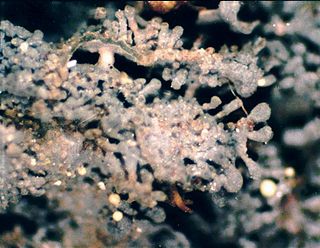
An isidium is a vegetative reproductive structure present in some lichens. Isidia are outgrowths of the thallus surface, and are corticated, usually with a columnar structure, and consisting of both fungal hyphae and algal cells. They are fragile structures and may break off and be distributed by wind, animals, and splashing raindrops. In terms of structure, isidia may be described as warty, cylindrical, clavate (club-shaped), scale-like, coralloid (coral-shaped), simple, or branched.

Acarospora is a genus of lichenized fungi in the family Acarosporaceae. Most species in the genus are crustose lichens that grow on rocks in open and arid places all over the world. They may look like a cobblestone road or cracked up old paint, and are commonly called cobblestone lichens or cracked lichens,. They usually grow on rock, but some grow on soil (terricolous) or on other lichens. Some species in the genus are fungi that live as parasites on other lichens. Acarospora is a widely distributed genus, with about 128 species according to a 2008 estimate.
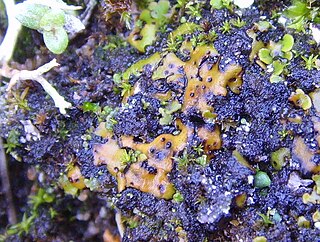
Placidium is a genus of crustose to squamulose to almost foliose lichens. The genus is in the Verrucariaceae family. Most members grow on soil, but some grow on rock (saxicolous). The fruiting bodies are perithecia, flask-like structures immersed in the lichen body (thallus) with only the top opening visible, dotting the thallus.

Devkund or Deokunda is naturally created pond located in the Mayurbhanj district of Odisha, India, and is part of the Simlipal National Park. The flowing water from an adjacent waterfall has created this pond. There is a temple called "Ambika Mandira" that was discovered by Rajkumar Prafulla Chandra Bhanja Deo, a researcher and a king during British Raj who stayed at Devkund and researched about this place. Debakunda is home to lichen species like Parmeliaceae.

Dalip Kumar Upreti (Dr.D.K.Upreti) is an Indian lichenologist. He served as Director and Chief Scientist at CSIR-National Botanical Research Institute, Lucknow during 1988 to 2017. Also he served as Head of Lichenology and herbarium division. Presently he is serving as Scientist Emeritus in the same division.

Crustose lichens form a crust that strongly adheres to the substrate, making separation from the substrate impossible without destruction. The basic structure of crustose lichens consists of a cortex layer, an algal layer, and a medulla. The upper cortex layer is differentiated and is usually pigmented. The algal layer lies beneath the cortex. The medulla fastens the lichen to the substrate and is made up of fungal hyphae. The surface of crustose lichens is characterized by branching cracks that periodically close in response to climatic variations such as alternate wetting and drying regimes.
A saxicolous lichen is a lichen that grows on rock. The prefix "sax" from the Latin saxum means "rock" or "stone".
A corticolous lichen is a lichen that grows on bark. This is contrasted with a lignicolous lichen that grows on wood that has had the bark stripped from it, and saxicolous lichens that grow on rock.
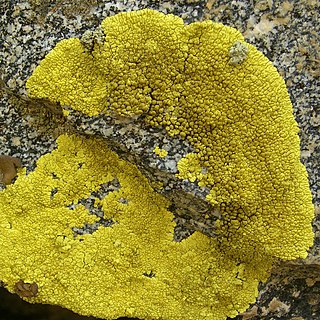
Pleopsidium flavum is a distinctively colored, bright lemon-yellow to chartreuse crustose lichen that grows in high elevations on vertical or overhanging hard felsic rock in western North America. Its thallus grows in a circular outwardly radiating pattern, with 1mm wide lobed edges. This is the identity of the vivid, lime-green lichens often photographed on granite boulders in the Wichita Mountains Wildlife Refuge of Oklahoma.
Clavascidium lacinulatum is a dark brown squamulous terricolous lichen. In Joshua Tree National Park, it is the most common of the biological soil crust lichens.
Heppia conchiloba is a gray to light brown squamulous to foliose terricolous lichen that in southwestern deserts of North America. The surface appears as if covered in a light dust (pruinose). The squamules are peltate, up to 8 mm in diameter. There are one to several apothecia per lobe, with reddish-brown urn shaped (urceolate) to concave discs, immersed so as to appear like concave spots. Lichen spot tests are all negative. Its entire thallus body is deeply convex, and it is different in color from other members of Heppia and or Peltula, which are olive or brownish-olive.
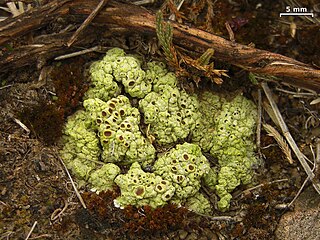
Acarospora schleicheri, the soil paint lichen, is a bleached to bright yellow areolate to squamulose lichen that commonly grows to 10 cm (4 in) on soil (terricolous) in arid habitats of southern California and Baja California, also in Europe and Africa. It produces rhizocarpic acid as a secondary metabolite, which gives it a yellow coloration and serves to protect it from the sun. Its lower surface is also yellow. It can be greenish when moist. Roundish, angular, or irregularly shaped squamules are 0.5–4 mm in diameter. There are 0–1 apothecia embedded in the thallus, with 0.4–1.2 mm roundish black to reddish-brown, or dark brown discs, which sometimes fill the areola so as to be lecanorine. It divides vegetatively on the soil. Asci are club shaped (clavate) and have 100 or more spherical to ellipsoid spores. Lichen spot tests are negative, and it is UV+ orange under ultraviolet light.
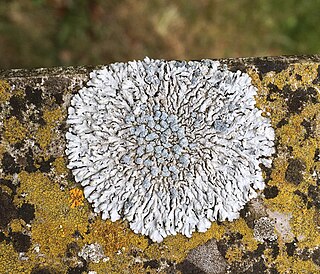
Physcia caesia, known colloquially as blue-gray rosette lichen and powder-back lichen, is a species of foliose lichenized fungus. First described by Georg Franz Hoffmann in 1784, it is common across much of Europe, North America and New Zealand, and more patchily distributed in South America, Asia, Australia and Antarctica. There are 2 subspecies, P. c. caesia and P. c. ventosa, as well as a number of distinct forms and varieties. Molecular studies suggest that the species as currently defined may be polyphyletic. It is typically pale gray shading to darker gray in the center, and grows in a small rosette, usually some 2–3 cm (0.79–1.18 in) across at maturity. It only rarely has apothecia, instead reproducing most often vegetatively via soredia, which are piled in round blue-gray mounds across the thallus's upper surface. It grows most often on rock—principally calcareous, but also basaltic and siliceous—and also occurs on bone, bark and soil. It is nitrophilic and is particularly common on substrates where birds perch.
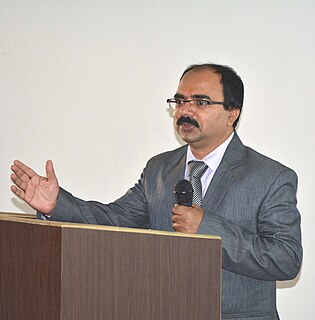
Sanjeeva Nayaka is a well-known Lichenologist of India, currently working as Principal Scientist at CSIR-National Botanical Research Institute (CSIR-NBRI), Lucknow. He is also in-charge of Algology Laboratory at the same institute; Secretary of ‘Indian Lichenological Society’ and ‘Lucknow Kannada Association’. Dr. Nayaka is an Associate Editor of the journal ‘Cryptogam Biodiversity and Assessment’.














